Before you pick up the knitting needles, you need to choose a beautiful pattern and suitable yarn. Having found an interesting solution or a combination of different patterns, you can knit attractive things according to the description with patterns for yourself or as a gift.
Simple knit and purl stitch patterns
Patterns of face and back loops are suitable for needlewomen whose goal is original and practical things. If you combine the execution of back and front loops with knitting needles, you get beautiful patterns. They are used to knit head accessories, cardigans and warm coats. Various options for such patterns are presented with diagrams and descriptions.
Stockinet
View from the outside and inside.
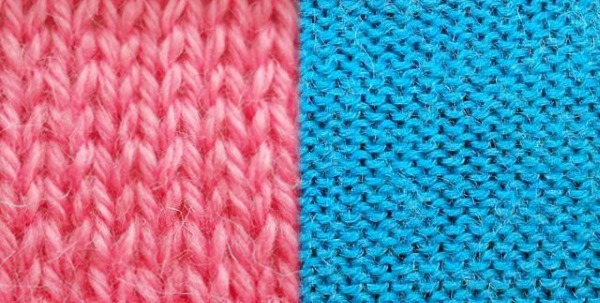
One of the simplest techniques for creating things is stocking stitch, which forms the same pattern on both sides. Many spectacular models are made by alternately knitting rows of basic loops. To prevent the edge of the product from curling, at the beginning of knitting you can knit several lines, alternating loops.
Pattern with description for stocking stitch:



- 1st row and odd: make knit stitches, transfer the 1st “edge” to the right knitting needle.
- 2nd row and even: internal (purl), 1st re-slip.
For a smooth edge of the fabric, the outer loop is always made with a purl stitch. It gives a vertical effect. When knitting in a circle, for the outer side, always make a knit stitch, for the inner side, a purl stitch. The lines do not alternate. The outer side of the product will be made with a front surface, and the inner side will be made with a back surface. The result is a double-sided product.
Garter stitch
The same fabric on both sides, the production of which has its own peculiarities. This is a universal and simplest pattern to perform, which is knitted either with external loops or internal ones. With any knitting execution, the effect will be almost the same. The edges do not curl and the thing is not subject to deformation.
Knitting methods:
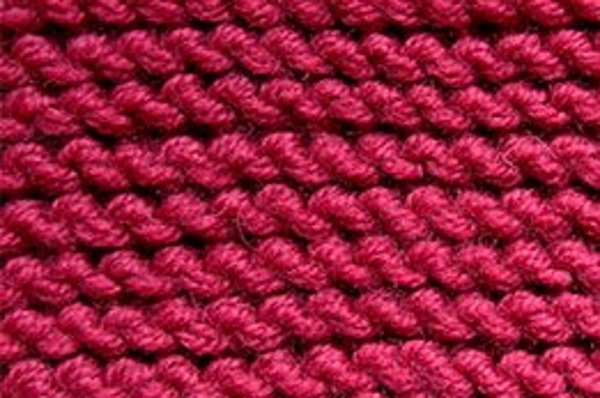 | "Grandma's" option. Perform the capture of the thread by the back lobes of the loop |
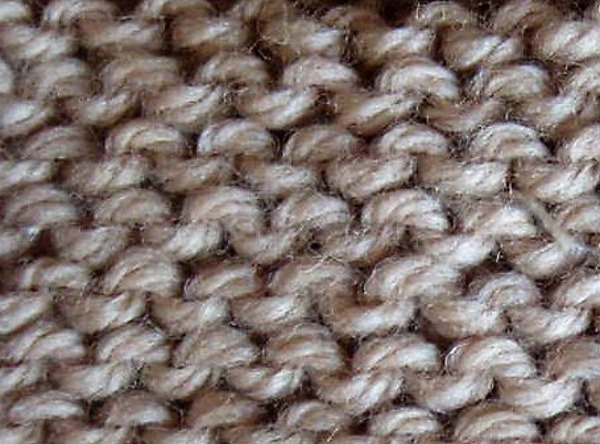 | Classic external loops, the thread is caught by the front lobes of the loops |
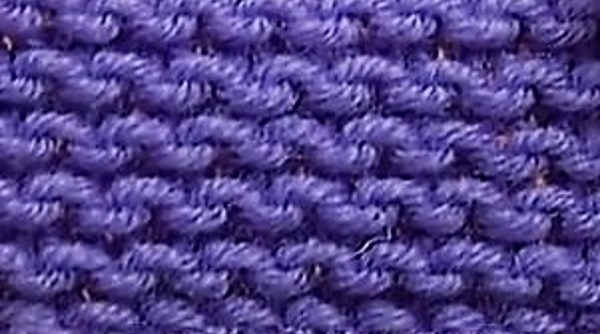 | Knitting exclusively with purl stitches loops, the effect is a little wider and looser |
Scheme and description:
| + | □ | □ | □ | □ | □ | □ | □ | + |
| + | □ | □ | □ | □ | □ | □ | □ | + |
| + | □ | □ | □ | □ | □ | □ | □ | + |
| + | □ | □ | □ | □ | □ | □ | □ | + |
- 1 row: The 1st st is transferred to the knitting needle in the right hand, the entire row is knit st, kr.
- 2nd row: made with faces, 1st is removed, the last one is the edge.
- 3rd and the following lines are the front p-li, 1st and outer edge.
| □ | External (front) p. |
| ■ | Inner (wrong side) |
| + | Edge |
| + | ■ | ■ | ■ | ■ | ■ | ■ | ■ | + |
| + | ■ | ■ | ■ | ■ | ■ | ■ | ■ | + |
| + | ■ | ■ | ■ | ■ | ■ | ■ | ■ | + |
| + | ■ | ■ | ■ | ■ | ■ | ■ | ■ | + |
- 1 row: The first one is transferred to the right knitting needle, then purl stitches, the last one is removed.
- 2nd row: internal (purl), 1st is re-sketched, the last one is red.
- 3rd and the following lines: purl sts, 1st and outer edge.
Since there is no inner side in the circular execution and it is not possible to turn the item, one row is knitted with knit stitches, the other with purl stitches (the beginning of the line closed in a circle can be marked with a marker), there are no edge stitches. To avoid twisted loops, you need to insert the knitting needle into the loop from the opposite side, as if untwisting it.
Rice
A beautiful double-sided pattern that even a beginner can handle. Another name for it is a tangle or pearl. This version of the pattern looks great on children's clothes, snoods and warm outerwear. It is often used as a background for complex designs. A simple knitting pattern on a diagram with a description.
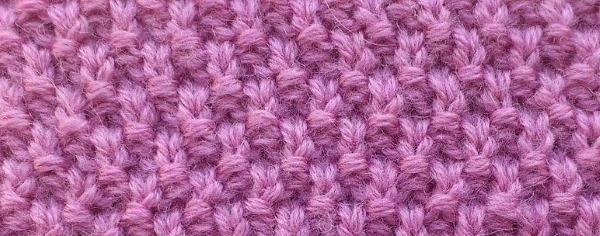
| Repeat from 1st row | 5 | ||||||||||
| 4 | + | O | ■ | O | ■ | O | ■ | O | ■ | + | |
| + | O | ■ | O | ■ | O | ■ | O | ■ | + | 3 | |
| 2 | + | ■ | O | ■ | O | ■ | O | ■ | O | + | |
| + | ■ | O | ■ | O | ■ | O | ■ | O | + | 1 | |
| 10 | 9 | 8 | 7 | 6 | 5 | 4 | 3 | 2 | 1 | ||
| O | Persons p. |
| ■ | Purl p. |
| + | Edge |
The loops are divided into 2 (multiples of 2). Perform the work, alternating the loops. Continue until the end of the line, knitting the rapport between the signs *…*.
Step by step knitting process:
- 1 row: 1st slip, *front loop, back loop*, last edge.
- 2nd row: 1st slip, *purl loop, knit loop*, last st edge.
- 3rd row: 1st slip, *purl loop, knit loop*, last st edge.
- 4th row: 1st slip, *purl loop, knit loop*, last st edge.
- 5th row: repeat from row 1.
As a result, the pattern shifts by 1 st through each line of the pattern.
Description of execution in a circle:
| Repeat 1st row | |||||||
| O | ■ | O | ■ | O | ■ | O | ■ |
| O | ■ | O | ■ | O | ■ | O | ■ |
| ■ | O | ■ | O | ■ | O | ■ | O |
| ■ | O | ■ | O | ■ | O | ■ | O |
The number of loops is even. Close the collected sts into a ring, put a marker so as not to lose the beginning of the line.
Repeat the stitches between the *…* symbols until the row ends:
- 1st row: knit stitch.
- Row 2: reaching the marker, *front loop, one purl *.
- 3rd row: *purl, knit*.
- 4th row: *purl, knit*.
- 5th row: *front, back*.
- Row 6: repeat rows 2 through 5.
Types of knitting the "Rice" pattern and its execution in various variations.
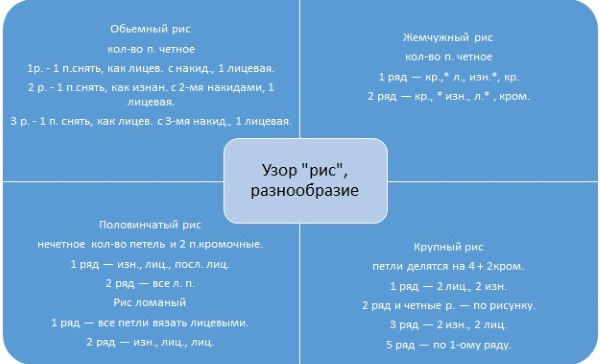
It looks decent and is in no way inferior to even the most complex drawings.
Rubber bands
Beautiful knitting patterns with diagrams and descriptions of knitted elastic bands, which are present in almost all knitted products. Knitting with elastic bands is widely used not only for decoration, but also for whole products, performing a pattern as the main pattern. The result of such creativity is a comfortable and original thing.
English elastic for scarves
Scarves and hats are mostly made using the English rib knitting technique. Double-sided knitting is beautiful, voluminous and stretches well.

Features of this technique: considerable yarn consumption, to avoid distortion of the pattern, knit the outer loops behind the back wall and the inner loops behind the front wall.
Knit loosely.
The simplest knitting option:
| 2p. | ∩ | = | ◢ | ∩ | = | ◢ | |
| ◢ | = | ∩ | ◢ | = | ∩ | 1p. | |
| 6 | 5 | 4 | 3 | 2 | 1 |
| ∩ — Yarn over. Pick up the thread from below |
| ◢ — Insert the knitting needle away from you behind the front segments of the loops and 2 loops will be the front loops |
| = Slip the loop so that the thread remains behind the needle |
The number of loops is odd, that is, a multiple of 3.
Repeat knitting the group of loops between the signs *…* until the line ends:
- 1 row: edge, *yarn over, slip 1 knit stitch unknitted, 2 knit stitches, yarn over, slip 1 knit stitch, 2 knit stitches *, edge stitch is knitted as purl.
- 2nd row: edge, *yarn over, 1 knit without knitting, 2 knit together *, outermost purl.
That is, make a stitch with a yarn over as a front stitch, and slip the next stitch and make a yarn over. Repeat 1 and 2 rows.
Convex elastic band
This design is more embossed and expressive, and looks impressive on voluminous items:
| 2p. | ∩ | = | ∩ | = | ◢ | ▨ | ◢ | ▨ | |
| ▨ | ◢ | ▨ | ◢ | = | ∩ | = | ∩ | 1p. | |
| 6 | 5 | 4 | 3 | 2 | 1 |

Designations:
| ∩ — Yarn over. The yarn is caught with the knitting needle. |
| ◢ — Insert the needle from the front and knit 2 stitches together |
| = - Remove the stitch without knitting it so that the thread remains behind the needle |
| ▨ — No loop |
The loops must be even.
Repeat knitting the group of loops between the signs *…* until the line ends:
- 1 row: cr., *yarn over, slip each next 2 sts with yarn over, knit 2 sts together 2 times*, knit the outer st as if it were purl.
- 2nd row: cr., * yarn over, slip each next 2 sts with yarn over, knit 2 together 2 times *, edge purl.
That is, knit the loops with a yarn over in the previous row, slip the next st and knit a yarn over. Repeat from the 1st row. Using the technique of knitting in a circle, it is possible to knit an original snood scarf. The knitting principle is the same as on straight knitting needles, only the loops are closed in a ring and the beginning of the row is marked with a marker. Knit the last loop before the second row as a front loop.
French elastic for original scarves
The pattern created with this technique will be voluminous in structure, similar to corrugation. Ideal for knitting scarves and hats, as well as children's items.

| Repeat subsequent rows from the first row | ||||||||
| ■ | ■ | □ | □ | ■ | ■ | □ | □ | ■ |
| □ | ■ | ■ | □ | □ | ■ | ■ | □ | □ |
| □ | Face-to-face |
| ■ | Wrong side |
The number of loops is a multiple of four and 1 for symmetry. Repeat from * to *.
The pattern shifts by one loop of each line:
- 1st row: *2 knit stitches, 2 purl stitches*, 1 knit stitch, turn the fabric.
- 2nd row: *2 purl sts, 2 knit sts*, 1 purl st.
Pearl gum
Simple technique. The design has an outer (looks like English elastic) and an inner (pearl pattern) side. The fabric is dense and soft.

| 2p. | ▢ | ◢ | ▨ | ▢ | ◢ | ▨ | |
| ▢ | = | ∩ | ▢ | = | ∩ | 1p. |
| ∩ — Yarn over. Insert the needle away from you. |
| ◢ - 2 together persons-oy. |
| = - Remove without knitting so that the thread remains behind the knitting needle. |
| ▢ — Face is a front loop, back is a back loop. |
| ▨ — No loops. |
Cast on an even number of stitches.
Repeat knitting the group of loops between the signs *…* until the end of the row:
- 1 row: *yarn over, slip 1 st, knit 1*, to the end of the line.
- 2nd row: * 1 purl, 1 stitch with yarn over knit. p. *.
1st and 2nd row repeat.
Scotch elastic
This elastic band is elastic and voluminous. It is suitable for making warm clothes and head accessories.
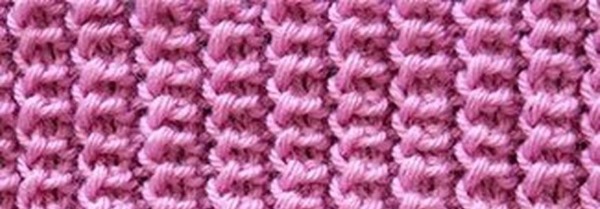
The texture is quite dense.

| External (front) from the face. Inner (wrong) with wrong side. | |
| Inner (wrong) side to the front side and vice versa. | |
| Yarn over. Grab the yarn from your right hand with the knitting needle from below towards you. | |
| Thrown loop. Left needle
catch the loop, pulling up the next 2 sts. | |
| There is no loop. |
The number n is a multiple of 3.
Repeat knitting from the * sign until the line ends:
- 1 row: *2 l., 1 out.*
- 2nd row: *1 l p, yarn over, 2 l p, throw the yarn over the outer 2 l p.*
- 3rd row: repeat from 1st row.
There are many variations of knitting elastic bands: fluffy, dense, voluminous and not so much.
The most popular of them are described here.
Relief patterns
Beautiful knitting patterns with diagrams and descriptions by combining facial loops with purl ones. Due to the convex and dense texture of the fabric, you can get various things.
Small honeycombs
The one-sided pattern resembles a honeycomb. It can be used to knit warm items, from hats to sweaters and cardigans.
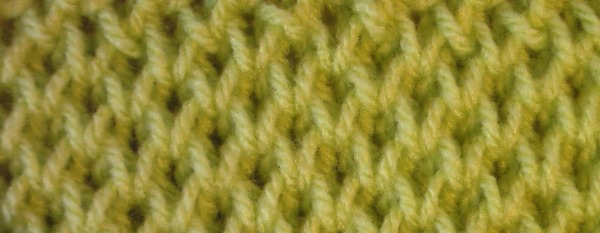
| 6p. | + | 2/ | ∩ | = | 2/ | ∩ | = | 2/ | ∩ | = | + | |
| + | = | l | l | = | l | l | = | l | l | + | 5p. | |
| 4p. | + | ∩ | = | 2/ | ∩ | = | 2/ | ∩ | = | 2/ | + | |
| + | l | = | l | l | = | l | l | = | l | + | 3p. | |
| 2p. | + | 2/ | ∩ | = | 2 / | ∩ | = | 2/ | ∩ | = | + | |
| + | = | ∩ | l | = | ∩ | l | = | ∩ | l | + | 1p. |
∩ Yarn over.
= Re-shoot, no need to knit.
l Front loop.
2/2 sts together outer (front).
+ Edge.
The number of loops must be divisible by 2, that is, be even, the last edge stitch must be purl:
- 1 row edge — kr. p., yarn over, remove st. Knit to the end of the row.
- 2nd row: cr., *knit 2 knit stitches together, yarn over and slip next stitch*.
- 3rd row: kr., 1 l. p., 1 p. slip, then alternate 2 l. p., 1 slip, kr.
- 4th row: kr., yarn over, slip unknitted, repeat: 2 together with outer loop, yarn over, slip st., kr.
- 5th row: cr., 2 l. p., 1 p. is removed, repeat until the end of the line.
Repeat from rows 2-5.
Wave
The entire pattern repeat is 14 lines, an even number of loops + one for symmetry:
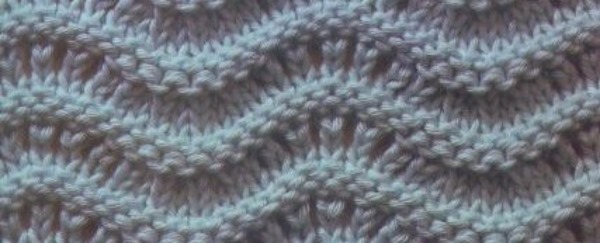
| 14p. | | | | | | | | | | | | | | | | | | | | | | | |
| ▬ | ▬ | ▬ | ▬ | ▬ | ▬ | ▬ | ▬ | ▬ | ▬ | ▬ | 13p. | |
| 12p. | | | | | | | | | | | | | | | | | | | | | | | |
| ▬ | ▬ | ▬ | ▬ | ▬ | ▬ | ▬ | ▬ | ▬ | ▬ | ▬ | 11p. | |
| 10r. | ▬ | ▬ | ▬ | ▬ | ▬ | ▬ | ▬ | ▬ | ▬ | ▬ | ▬ | |
| ◢ | | | | | | | ∩ | ▬ | ∩ | | | | | | | ◣ | 9p. | |
| 8p. | ▬ | ▬ | ▬ | ▬ | ▬ | ▬ | ▬ | ▬ | ▬ | ▬ | ▬ | |
| ◢ | | | | | | | ∩ | ▬ | ∩ | | | | | | | ◣ | 7p. | |
| 6p. | ▬ | ▬ | ▬ | ▬ | ▬ | ▬ | ▬ | ▬ | ▬ | ▬ | ▬ | |
| ◢ | | | | | | | ∩ | ▬ | ∩ | | | | | | | ◣ | 5p. | |
| 4p. | ▬ | ▬ | ▬ | ▬ | ▬ | ▬ | ▬ | ▬ | ▬ | ▬ | ▬ | |
| ◢ | | | | | | | ∩ | ▬ | ∩ | | | | | | | ◣ | 3p. | |
| 2p. | ▬ | ▬ | ▬ | ▬ | ▬ | ▬ | ▬ | ▬ | ▬ | ▬ | ▬ | |
| ◢ | | | | | | | ∩ | ▬ | ∩ | | | | | | | ◣ | 1p. | |
| 11 | 10 | 9 | 8 | 7 | 6 | 5 | 4 | 3 | 2 | 1 |
Designations:
| ▬ | Purl p. |
| | | Lic. p. |
| ∩ | Yarn over |
| ◣ | 2 loops knitted together externally (front), catch the thread from behind (by the back segments) |
| ◢ | 2 loops knitted together, thread caught in front (by the front lobes) |
Description:
- 1 row: 2p. together knit stitches, 3 outer (knit stitches), yarn over, knit stitch, yarn over again and 3 knit stitches, the last 2 together, catching the working thread from the front, that is, from the front lobes of the loop.
- 2nd row: knit with internal (purl) loops until the row ends.
- 3rd, 5th, 7th, 9th according to 1st.
- 4p.: — Rows 10 and 11, 13 must be done completely inside out.
- 12th, 14th: completely external (personal n-mi).
The wave pattern can be done and varied in different ways by increasing or decreasing the number of stitches connected together.
Honeycombs
The number of loops is a multiple of 6 (this includes the edge loop):
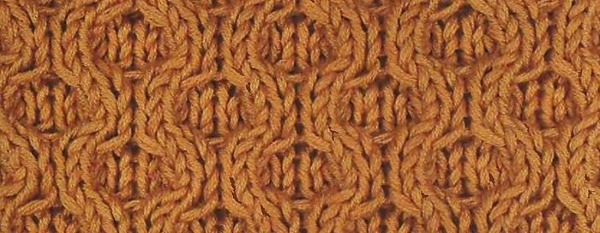
| 8p. | + | ▬ | ▬ | ▬ | ▬ | = | = | ▬ | ▬ | |
| | | | | = | = | l | l | | | l | + | 7p. | |
| 6p. | + | ▬ | ▬ | ▬ | ▬ | = | = | ▬ | ▬ | |
| | | | | = | = | l | l | | | l | + | 5p. | |
| 4p. | + | ▬ | ▬ | ▬ | ▬ | = | = | ▬ | ▬ | |
| | | | | = | = | l | l | | | l | + | 3p. | |
| 2p. | | | | | | | | | | | | | | | | | | | |
| ▬ | ▬ | ▬ | ▬ | ▬ | ▬ | ▬ | ▬ | ▬ | 1p. |
Designations:
| = | Transfer to another needle |
| l | Facial |
| ▬ | Purl p. |
| + | Edge |
Knitting process:
- 1 row: purl p.
- 2nd row: persons. p.
- Row 3: 1 kr., 4 l. p., 2 p. slip (working thread at the back) and so on until the row ends.
- Row 4: you need to do it like this: knit, 4 purl, 2 slip (working thread in front), so on until the row ends.
- Row 5: repeat 3rd.
- Row 6: repeat line 4.
- Row 7: repeat 3rd.
- Row 8: similar to the 4th.
Repeat the pattern from the beginning.
Shells
The result of the work will be a good density of the product. The pattern will suit both warm and cold weather products, depending on the selected yarn and thread thickness.

The number of stitches you need to cast on is a multiple of six minus 1:

| Front rows - front loops, back rows - back loops. | |
| In the front row - purl, in the back row - front loops. | |
| Knit 5 loops from 5 loops. |
Description of the pattern execution:
- 1st and 5th rows: persons. p.;
- 2nd, 6th rows: knit;
- 3rd row: knit *5 loops out of five, 1 front.*
- 4th, 8th rows: knit purlwise,
- 7th row: make 3 front loops, from *5 knit another 5, 1 front loop. * then 2 front loops.
The rapport is repeated from the beginning. To knit 5 sts out of 5, insert the knitting needle in the right hand through 5 loops, pull the captured thread through the loops, leave the loops on the left knitting needle as is. Then the algorithm is as follows: yarn over, repeat knitting the second loop out of five, until you get 5 loops.
Braids and plaits
Beautiful knitting patterns with diagrams and descriptions of cables and braids are knitted using an additional knitting needle. They are a great addition to any knitted product or whole items consisting exclusively of braids or cables. These patterns are similar in knitting technique.
Simple tourniquet
Loops multiple of 19


- 1 row: *3 purl sts, 13 knit sts*, repeat loops between signs *…* until end of row, 3 purl sts.
- 2nd and even lines: how the loops look.
- 3rd: *3 purl, 3 knits transfer to an additional knitting needle and leave on the back, 3 knits from the knitting needle in the left hand, 3 knits with an auxiliary knitting needle, 1 knit, 3 knit loops transfer to an additional knitting needle and leave on the front side, 3 knits from the knitting needle in the left hand, 3 knits with an auxiliary knitting needle*, knit again from the * sign until the end of the row, at the end 3 internal loops (purl).
Repeat the lines from the first row. The principle of knitting cables is that part of the loops is removed to an additional knitting accessory in front or behind the fabric and knitted after knitting the loops on the knitting needle in the left hand.
Narrow tourniquet
Cast on so that the number of loops is a multiple of 8.

- 1 row: *2 out. p., 4 l. p.*, repeat between the rapport signs*…* until the end of the row, finish the line with two purl.
- 2nd and even: follow the drawing.
- 3rd: * 2 purl, 2 loops on an additional needle in front of the work (or behind, but always in the same direction), 2 l p, 2 l p from an additional needle*, repeat from *, finish the row with two purl.
Scythe
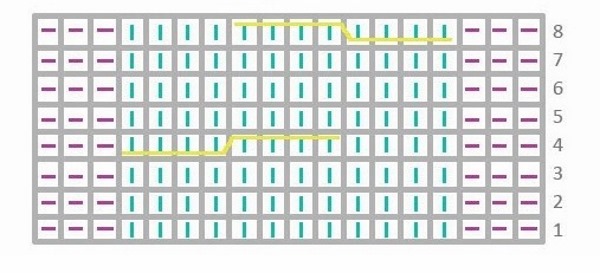

- 1 row: 3 purl, 12 knit, 3 purl.
- 2nd, 3rd: how the loops look.
- 4th: 3 purl, 4 knits, transfer 4 sts to additional knitting accessory and leave on the wrong side, 4 knits + 4 from additional tool.
- 5th, 6th, 7th rows: how the loops look.
- 8th: 3 out., 4 sts on the additional accessory in front of you, knit 4 loops 4 from the additional tool.
Repeat from row 1.
Openwork patterns
Beautiful knitting patterns with diagrams and descriptions of openwork are a combination of stocking or garter stitch knitting techniques with yarn overs. The resulting product is elastic. You should not make yarn overs in the product immediately and on the sides.
Openwork wave
The method of knitting the wave guarantees not only a beautiful and voluminous, but also a warm product:
| 6p. | | | ∩ | | | ∩ | | | ∩ | | | ∩ | | | ∩ | | | ∩ | | | ∨2 | ∨2 | |
| ▬ | ▬ | ▬ | ▬ | ▬ | ▬ | ▬ | ▬ | ▬ | ▬ | ▬ | ▬ | ▬ | ▬ | ▬ | 5p. | |
| 4p. | | | ∩ | | | ∩ | | | ∩ | | | ∩ | | | ∩ | | | ∩ | | | ∨2 | ∨2 | |
| ▬ | ▬ | ▬ | ▬ | ▬ | ▬ | ▬ | ▬ | ▬ | ▬ | ▬ | ▬ | ▬ | ▬ | ▬ | 3p. | |
| 2p. | | | | | | | | | | | | | | | | | | | | | | | | | | | | | | | |
| ▬ | ▬ | ▬ | ▬ | ▬ | ▬ | ▬ | ▬ | ▬ | ▬ | ▬ | ▬ | ▬ | ▬ | ▬ | 1p. | |
| 16 | 15 | 14 | 13 | 12 | 11 | 10 | 9 | 8 | 7 | 6 | 5 | 4 | 3 | 2 |
Designations:
| ▬ | Purl p. |
| l | Facial |
| ∩ | Yarn over |
| ∨2 | Two l.p. together |
Even number of loops:
- The 1st row is made entirely with purl loops.
- The 2nd row is made entirely with knit stitches.
- 3rd row purl.
- The 4th row should be done like this: 1 knit, yarn over (six times), then 2 p. knit together (three times).
- 5th row with internal (purl) loops.
- 6th row similar to 4.
- Row 7: repeat from 1-6.
Openwork pattern including braid
Rapport 15 loops. The pattern on the diagram is from the front side.

Designations:
| Empty cells | persons. p. |
| Front 2 together sts, tilt to the right | |
| Front 2 together sts, tilt to the left | |
| yarn over | |
| 8 sts crossed to the right |
- 1 row: l. p., yarn over, 2nd l. p. together with a left tilt, 1 l. p., transfer 4 loops to an additional accessory, knit 4 front loops + 4 with a vsp. sp., 1 l. p., 2nd together with a right tilt, yarn over, 1 l. p.
- 2nd row and even: how the loops look, according to the pattern (this will be the inside of the knitting, the loops on the wrong side).
- 3rd and odd: 2 l.p., yarn over, 2 l.p. together with a tilt to the left, 8 front loops, 2 together with a tilt to the right, yarn over, 2 l.p. (add 1 front loop along the edges in each line, accordingly decrease the number of loops inside by 2, that is, instead of 8 sts, knit 6, 4.)
From the 7th row the pattern is repeated from the beginning.
Knitting patterns for children's clothes
The simplest and most straightforward pattern in children's things will look interesting and fun. It is preferable to choose elastic or openwork knitting for children's products so that it is elastic and does not create discomfort for the child.

Pattern for warm outerwear:
- 1 row: 2 purl sts, transfer 4 sts to an additional knitting accessory, wrap the loops with yarn several times and transfer them again to the knitting needle in the left hand, knit the front loops from the transferred loops, 2 purl sts.
- 2nd, 3rd row: 2 out. p., 4 l. p., 2 out. p.
- 4th row: Slip 2 sts onto an additional needle to the front side, then 2 purl sts + 2 sts from an additional needle, slip 2 sts onto an additional needle to the back side, then 2 kn sts + 2 sts from an additional needle.
- 5th, 6th rows: similar to the second row.
- 7th row: 2 sts. transfer to an additional tool, wrap loops 2 times with thread, transfer back and knit externally (front st), 4 out. sts., 2 sts. transfer to an additional tool, wrap loops 2 times with thread, transfer back and knit externally (front st).
- 8th, 9th: like the second one.
- 10th row: Slip 2 sts onto an additional knitting needle to the wrong side, then 2 knit sts + 2 sts from an additional knitting needle, also perform in mirror image with 4 loops further.
- 11th, 12th row: similar to the second one.
The pattern is then repeated. A very simple design resembles circles or pearls.

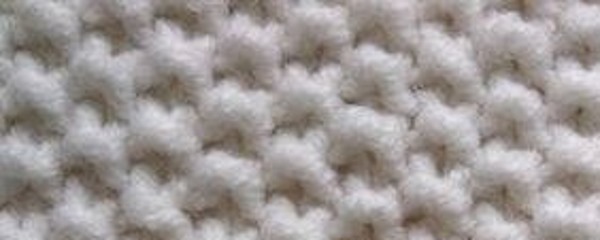
Cast on 2 edges and a multiple number of stitches:
- 1st row: *l. p., iz. p.*, repeat from the symbol “*” to the end of the line.
- 2nd and perform the remaining lines in accordance with the 1st row.
Knitting gives you complete freedom in creating a product of the desired size, density and color.
It can be very simple or very complex. Simple to perform and beautiful patterns with knitting needles, combining loops is the basis in knitting. With the scheme and description, everyone can cope with them, even the most inexperienced beginner.
Article formatting: Anna Vinnitskaya
Video about beautiful patterns
10 selections of beautiful knitting patterns with descriptions and diagrams:
